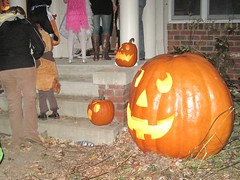Grenouille, the central character in Patrick Süskind's bestseller
Perfume, is missing something: something needed to make him fully or even minimally human. As a baby, born to an unmarried fishwife in mid-18th century Paris, he's rejected by his wet nurse. She perceives that physically what he's missing is any odor. "He's possessed by the devil," she says.
The priest who is responsible for the baby responds: "Impossible! It is absolutely impossible for an infant to be possessed by the devil.... Does some evil stench come from him?"
The nurse replies, "He doesn't smell at all." The priest demands details. She explains that the baby Grenouille doesn't smell "like human children ought to smell," which after quite a bit of questioning on the part of the priest she explains thus:
"They smell good all over. ... Their feet, for instance, they smell like a smooth, warm stone -- or no, more like curds... or like butter, like fresh butter.... And their bodies smell like ... like a griddle cake that's been soaked in milk. And their heads... smell best of all. [The crown of a baby's head] smells like caramel, it smells so sweet, so wonderful.... And that's how little children have to smell -- and no other way." (p. 12-14)
Odors, aromas, smells, stinks, miasmas, and above all perfumes dominate the intensely vivid descriptions of the book. It begins with all the stinks of the streets, markets, tanneries, stables, and waterways of Paris in that era, as the odorless baby and then child develops into a strange, unlikeable, and self-absorbed person. Having no smell himself, Grenouille nevertheless has a heightened sense of smell, a phenomenal memory for aromas and odors, and a vaguely inhuman way of reacting to them.
But Grenouille isn't just a man without his own natural smell, he's a man without humanity. In an effort to compensate for his missing human odor, he desperately apprentices himself to a perfumer, where he demonstrates remarkable abilities to create pomades, perfumes, elixirs, and other cosmetic preparations. He learns to capture aromas from both the inanimate (like a metal door knob) and the living (like a puppy). However, with a cold-blooded lack of compassion or any feeling at all, he grasps that it's necessary to kill in order to capture the aroma he finds most compelling -- that of a beautiful girl on the threshold of womanhood. The last part of the book turns into a horror story as he becomes an increasingly inhuman serial killer, and ends with a surprising and dreadful conclusion.
 |
| So many editions of Perfume in this screen shot from google images suggest how very popular it's been since publication in 1985. |
Recent books I've read about the neuroscience of the senses of smell and taste and how the brain processes them often mention Süskind's book, which was published in 1985, at about the same time as the earliest modern studies of the subject. Süskind's descriptions of the mechanisms of smell are very interesting in this context. Grenouille can recall every smell he ever sensed. He can distinguish individual aromas in blended perfumes or streets full of multiple smells. These abilities seem to go far beyond what scientific tests show actual humans are capable of.
Scientific studies usually focus on the interaction of smell and taste, what one author calls "how the brain creates flavors." Süskind's character seems to find the taste of food unrelated to the complex and well-developed sense of smell that distinguishes him from other humans. In one long section, Grenouille lives as a recluse in a mountain cave, during which time he eats lizards and other vermin with no sense of disgust. Maybe his name -- meaning frog in French -- is relevant to this part of the tale. Other than his having been a very greedy baby (another fault found by the wet nurse) and despite his constant obsession with aromas, there's little about food, flavors, or cooking in the book at all -- only smells.

























































